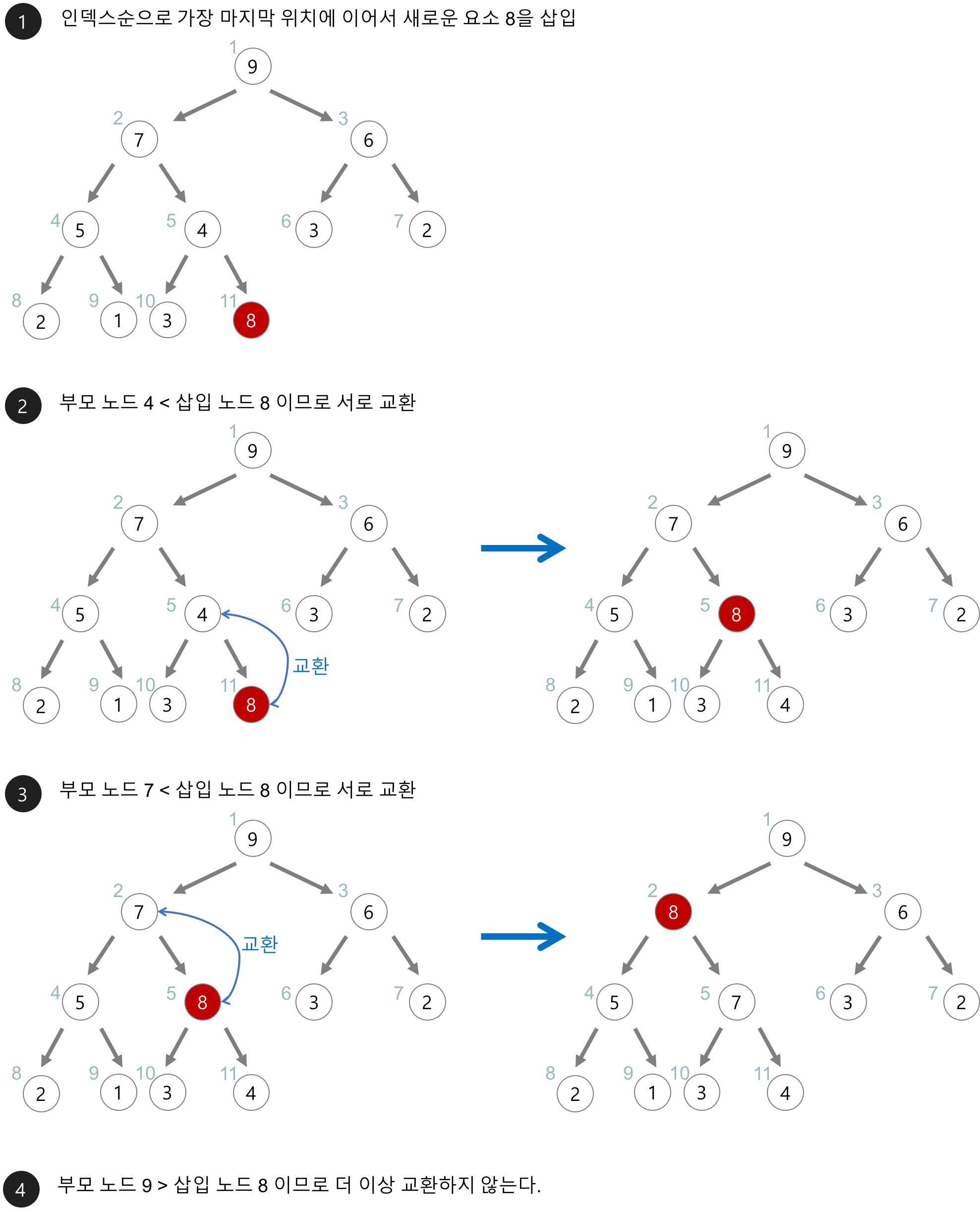https://www.daleseo.com/python-heapq/
[파이썬] heapq 모듈 사용법
Engineering Blog by Dale Seo
www.daleseo.com
https://gmlwjd9405.github.io/2018/05/10/data-structure-heap.html
[자료구조] 힙(heap)이란 - Heee's Development Blog
Step by step goes a long way.
gmlwjd9405.github.io
먼저, 글을 작성하기에 앞서 위 두 블로그의 글을 참고했다는 점을 알린다. Heap 자료구조를 공부하는데 큰 도움이 되었다.
힙 자료구조
- "우선 순위 큐"를 위해 만들어진 자료구조
- "완전 이진 트리(binary tree)의 일종이다.
- 여러개의 값들 중 최댓값이나 최솟값을 빠르게 찾아내도록 만들어진 자료구조이다.
- 중복된 값을 허용해준다.
힙의 종류
- 최대 힙
부모 노드의 키값이 항상 자식노드의 키 값보다 크거나 같은 완전 이진 트리
- 최소 힙
부모 노드의 키 값이 항상 자식노드의 키 값보다 작거나 같은 완전 이진 트리




내가 받은 느낌은 Sorting을 빠르게 하거나, 최댓값, 최솟값 혹은 n번째 최댓값 최솟값을 빠르게 찾아 줄 수 있는 자료구조인것 같다.
힙의 구현(파이썬 heapq 모듈)
힙에 원소 추가
import heapq
heap = []
#heapq는 자체적인 자료구조가 아닌 리스트를 통해 구현
heapq.heappush(heap, 4)
heapq.heappush(heap, 1)
heapq.heappush(heap, 7)
heapq.heappush(heap, 3)
print(heap)
# [1, 3, 7, 4]
# 가장 작인 1이 인덱스 0(최소 힙을 만들기 때문에 무조건 0번째 인덱스는 최소값이다.
# 인덱스 1(=k)에 위치한 3은 인덱스 3(2k+1)에 위치한 4보다 크므로 힙의 공식을 만족
힙에서 원소 삭제
print(heapq.heappop(heap))
#1
print(heap)
#[3,4,7]
#최소값인 1이 pop되어 리턴 되고, 그 다음으로 작았던 3이 인덱스 0으로 올라옴.
#최소값을 삭제하지 않고 얻기 위해서는
print(heap[0])
기존 리스트를 힙으로 변환
heap = [4,1,7,3,8,5]
heapq.heapify(heap)
print(heap)
#[1,3,5,4,8,7]
heap의 k번쨰 최소 / 최대 값 구하기
import heapq
def kth_smallest(nums, k):
heap = []
for num in nums:
heapq.heappush(heap, num)
kth_min = None
for _ in range(k):
kth_min = heapq.heappop(heap)
return kth_min
print(kth_smallest([4, 1, 7, 3, 8, 5], 3))heap 정렬
import heapq
def heap_sort(nums):
heap = []
for num in nums:
heapq.heappush(heap, num)
sorted_nums = []
while heap:
sorted_nums.append(heapq.heappop(heap))
return sorted_nums
print(heap_sort([4, 1, 7, 3, 8, 5]))'코딩테스트 공부 > Python' 카테고리의 다른 글
| Python) collections 내장 모듈 (0) | 2020.06.02 |
|---|---|
| 파이썬) 딕셔너리에 대해 알아보자 (0) | 2020.05.30 |
| Python) 빈 리스트 만들어보기 (Shallow Copy, Deep Copy) (0) | 2020.05.29 |